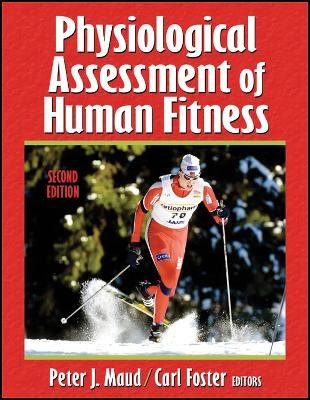
Physiological Assessment of Human Fitness
Human Kinetics (Verlag)
978-0-7360-4633-6 (ISBN)
- Titel ist leider vergriffen;
keine Neuauflage - Artikel merken
Peter J. Maud has more than 30 years' experience in teaching exercise physiology, conducting exercise physiological research, and performing human fitness evaluation. Peter currently serves as academic head of the department of physical education, recreation and dance at New Mexico State University. He is a fellow of the American College of Sports Medicine (ACSM) and a member of the American Alliance for Health, Physical Education, Recreation and Dance. Peter received his PhD from the University of New Mexico in 1974. Carl Foster is a professor of exercise and sport science at the University of Wisconsin-La Crosse and director of the Human Performance Laboratory at UW-L. He has written extensively on laboratory methods in exercise physiology and on the prediction of exercise capacity in both athletic and clinical populations. Foster is the president of the American College of Sports Medicine, a former associate editor in chief of Medicine and Science in Sports and Exercise, and a coeditor of ACSM's Health/Fitness Facility Standards and Guidelines. Since 1979, he has been coordinator of sports medicine and sport science for the U.S. International Speedskating Association. Carl received his PhD from the University of Texas at Austin in 1976.
Chapter 1. Fitness Assessment Defined
Peter J. Maud
-Historical Perspectives
-Energy Systems Approach
-Health Fitness
-Fitness Evaluation for Athletic Participation
-Perceptual Motor Domain
-Rationale for Text Test Items
-Summary
Chapter 2. Direct Determination of Aerobic Power
James A. Davis
-Measurement of VO2max
-Criteria for Achievement of VO2max
-Reference Values
-Summary
Chapter 3. Indirect Methods for Estimation of Aerobic Power
Vï¿œronique Billat
Philippe Lopes
-Indirect Estimation of VO2max Using Power Output or Velocity
-Determination of VO2max From Speed
-Determination of VO2max Using Nonexercise Measurements
-Estimation of VO2max Using Simple Calculations and the Critical Speed Concept
-Estimation of VO2max Using an Estimation of the Oxygen Cost of Running and Walking
-Estimation of VO2max Using a Heart Rate Monitor
-Estimation of VO2max From the Running or Walking Ascent of a Mountain
-Estimation of VO2max Using Heart Rate Variability at Rest
-Summary
Chapter 4. Heart Rate Variability: Measurement Methods and Practical Implications
Philippe Lopes
John White
-Control Mechanisms and the Conducting System
-Measurement Methods
-Practical Implications
-Practical Example
-Heart Rate Variability Measures in Coronary Heart Rate Disease Morbidity and Mortality
-Summary
Chapter 5. Blood Lactate, Respiratory, and Heart Rate Markers on the Capacity for Sustained Exercise
Carl Foster
Holly M. Cotter
-Relationship of Blood and Muscle Lactate
-Practical Significance of the Anaerobic Threshold
-Laboratory Approaches to Measurement
-Laboratory Concerns With Aerobic and Anaerobic Thresholds
-Summary
Chapter 6. Testing for Anaerobic Ability
Peter J. Maud
Joseph M. Berning
Carl Foster
Holly M. Cotter
Christopher Dodge
Jos J. deKoning
Floor J. Hettinga
Joanne Lampen
-Measurement of Peak and Mean Anaerobic Power
-Performance-Based Peak Anaerobic Power Tests
-Performance-Based Mean Anaerobic Power Tests
-Testing Issues
-Accumulated O2 Deficit
-Summary
Chapter 7. The Measurement of Human Mechanical Power
Everett Harman
-Quantitative Foundation of Power Testing
-Testing Strategy and Test Results
-Instrumentation
-Specific Applications
-Summary
Chapter 8. Strength Testing: Development and Evaluation of Methodology
William J. Kraemer
Nicholas A. Ratamess
Andrew C. Fry
Duncan N. French
-What Is Muscular Strength?
-Why Is Measurement of Strength Important?
-Physiological Adaptations Associated With Strength Training
-Testing Modalities
-Strength-Test Protocols for Repetition Maximums
-Isometric Testing
-Isokinetic Testing
-Overview of Testing Considerations
-Summary
Chapter 9. Skeletal Muscle Structure and Function
Michael McGuigan
Matthew Sharman
-Skeletal Muscle Structure and Function
-Needle Muscle Biopsy
-Processing Muscle Tissue
-Measures of Tissue Capillary
-Fiber Cross-Sectional Area
-Protein Quantification Through Bradford or Lowry Methods
-Immunohistochemistry for Steroid Receptor Analysis
-Western Blotting for Steroid Receptor Analysis
-Summary
Chapter 10. The Utility of Near Infrared Spectrophotometry in Athletic Assessment
Kenneth W. Rundell
Joohee Im
-NIRS Instrumentation
-Principle of NIRS Measurement
-Summary
Chapter 11. Anthropometry and Body Composition Measurement
Michael L. Pollock
Jill A. Kanaley
Linda Garzarella
James E. Graves
-Multicomponent Models
-Hydrostatic Weighing
-Air Displacement Plethysmography
-Anthropometry
-Bioelectric Impedance Analysis
-Ultrasound
-Dual-Energy Projection Methods
-Isotopic Dilution
-Magnetic Resonance Imaging and Computed Tomography
-Comparison Among Methods
-Normative Data
-Summary
Chapter 12. Static Techniques for the Evaluation of Joint Range of Motion and Muscle Length
Peter J. Maud
Kate M. Kerr
-Rationale for Measurement of Flexibility
-Methods of Measurement
-Trunk Range of Motion
-Neck Range of Motion
-Upper Limb Range of Motion
-Lower Limb Range of Motion
-Muscle Length Tests
-Summary
Chapter 13. Field Testing of Athletes
Carl Foster
Jack T. Daniels
Jos J. deKoning
Holly M. Cotter
-General Principles for the Field Laboratory
-Specific Field-Test Conditions and Consideration
-Measurement of Hemodynamics in the Field
-Measurement of Blood Lactate
-Other Useful Items for Your Traveling Laboratory
-Summary
| Erscheint lt. Verlag | 1.12.2005 |
|---|---|
| Verlagsort | Champaign, IL |
| Sprache | englisch |
| Maße | 216 x 279 mm |
| Gewicht | 1134 g |
| Themenwelt | Sachbuch/Ratgeber ► Sport |
| Medizin / Pharmazie ► Medizinische Fachgebiete ► Sportmedizin | |
| Studium ► 1. Studienabschnitt (Vorklinik) ► Physiologie | |
| ISBN-10 | 0-7360-4633-X / 073604633X |
| ISBN-13 | 978-0-7360-4633-6 / 9780736046336 |
| Zustand | Neuware |
| Haben Sie eine Frage zum Produkt? |
aus dem Bereich


